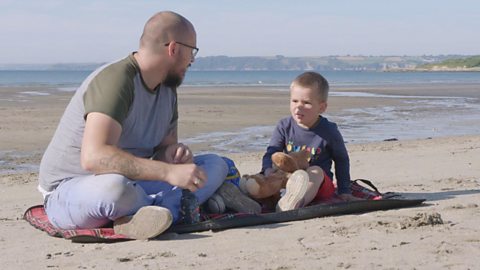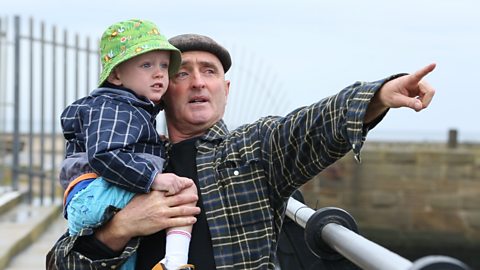A trip to the supermarket can be the perfect opportunity for language learning with your little one.
Talking with your child about the different things you can see and touch, like fruits and vegetables, helps them to expand their words and helps avoid any boredom.
Join Georgie and his mum on a trip around the shop in the video below.
Mum: Can Georgie grab the basket for Mummy?
TITLE: SHOPPING TIME
Mum: What are you going to put in your basket?
Georgie: Apples.
Mum: Apples. Good boy, Georgie.
Mum: Come on then, good boy.
TEXT: TURN SHOPPING INTO LANGUAGE LEARNING FUN!
TEXT: TALK ABOUT WHAT YOU ARE GOING TO BUY TO HELP EXPAND THEIR WORDS.
Georgie: Super apples!
Mum: Super apples, yeah. What about some potatoes?
Georgie: Super potatoes!
Mum: Super potatoes, yeah. What other things can we have?
Georgie: Carrots.
Mum: Carrots?
Georgie: A snowman. Build a snowman.
Mum: A snowman does have a carrot for his nose, doesn't he?
TEXT: PRACTISE COLOURS AND TRICKIER WORDS TOGETHER.
Mum: What colour are bananas?
Georgie: Yellow.
Mum: Yellow! And what colour are these grapes?
Georgie: Green.
Mum: Green! Ooh this is a funny one - what's this called?
Georgie: Pineapple.
Mum: Pineapple!
TEXT: SHOPPING BOREDOM SORTED!
Georgie: You're go pay them.
Mum: We're going to pay for them now, are we? Good boy, Georgie.
What are the language benefits of this activity?
In the supermarket, children get to use new words and phrases they might not use regularly.
It gives you lots of opportunities to ask them questions about the items you pick out.
It helps children build auditory and visual memory skills.
It gives children the chance to talk about the items you buy and add descriptive words around size, shape and texture.
It gives you the opportunity to interact positively together through chatting and taking turns in conversation.
Getting children involved helps to increase their attention span.
It lets children feel like they're being helpful when they put items in the basket and it's fun!
How to get the most out of a trip to the supermarket
Even before you set off for the supermarket there is opportunity to talk and plan ahead together.
Discuss what you are planning to buy, make a list together (you could make a picture list for your little one) and talk about things they like and don't like to eat.
When you arrive see if they can remember what was on the list - great for building up auditory memory skills - then see if they can find the items. You may need to give clues and reminders: 'Which fruit did we want to buy that was yellow? We have to peel them.'
Talking about fruit and vegetables in the supermarket is a great opportunity to expand on your child's vocabulary and link this to other experiences your child has had. For example, in the video, when Georgie picks up carrots, he links them to the word 'snowman' and his mum adds the word 'nose.'
Need more supermarket inspiration? Play 'What's in the shopping basket?' with your little one.
Mum: What's that?
Georgie: A pineapple!
Mum: A pineapple? That's really cool! You're going to put it in your basket?
TEXT: Shopping basket fun
Georgie: Yeah
Mum: Thank you.
TEXT: While shopping, help boost your child's language.
TEXT: Play 'What's in the basket?' to get them remembering and talking about items.
Mum: Can you tell Mummy what's in the basket?
Georgie: A nana!
Mum: Bananas. What else is in the basket? No peeking!
Georgie: Blueberries!
Mum: Blueberries.
TEXT: Count items together.
Georgie: Count 'em.
Mum: Shall we count them?
Georgie: One.
Mum: One.
Both: Two, three, four, five carrots! Wow!
TEXT: Talk about colours and repeat trickier words.
Mum: Ooh these are strawberries. What colour are strawberries?
Georgie: Red!
Mum: What is this called?
Georgie: Pine cone!
Mum: Pineapple. Yes it is a pineapple. What colour are the leaves?
Georgie: Green.
Mum: Green, they are. Shall we go to the till and pay now?
Georgie: Yeah.
Mum: Okay then.
Practise colours and trickier words together by asking your child questions like, 'What colour are bananas?'
Use describing words like smooth, spiky, small and big to 'add a word' - this will help your child learn to create longer sentences. For example, if they say 'pineapple', say back, 'yes, it's a spiky pineapple'.
If they make mistakes, or say a word wrong, that's okay, just repeat the word or sentence back to them correctly. In the film, Georgie calls a pineapple a 'pine cone', and his mum says, 'Yes, a pineapple!'
Talk about the past and future to help your child recognise tenses - you could talk about what you've already seen in the supermarket and where you might go next.
Play 'What's in the shopping basket?' together, a variation on What's in the bag? This will help them use their memory and vocabulary, as well as their counting skills.
When you get home you could play a putting away game - this helps build comprehension (understanding skills). Start by asking them to find one item then count up, depending on the stage your child is at. For example, 'Find the bananas and one carrot'.
Talk about where the shopping is stored to build sentences even further: 'The apples go in the fruit bowl. The grapes go into the fridge'. See if your child can guess where each item is stored.
What else can you do on a shopping trip?






